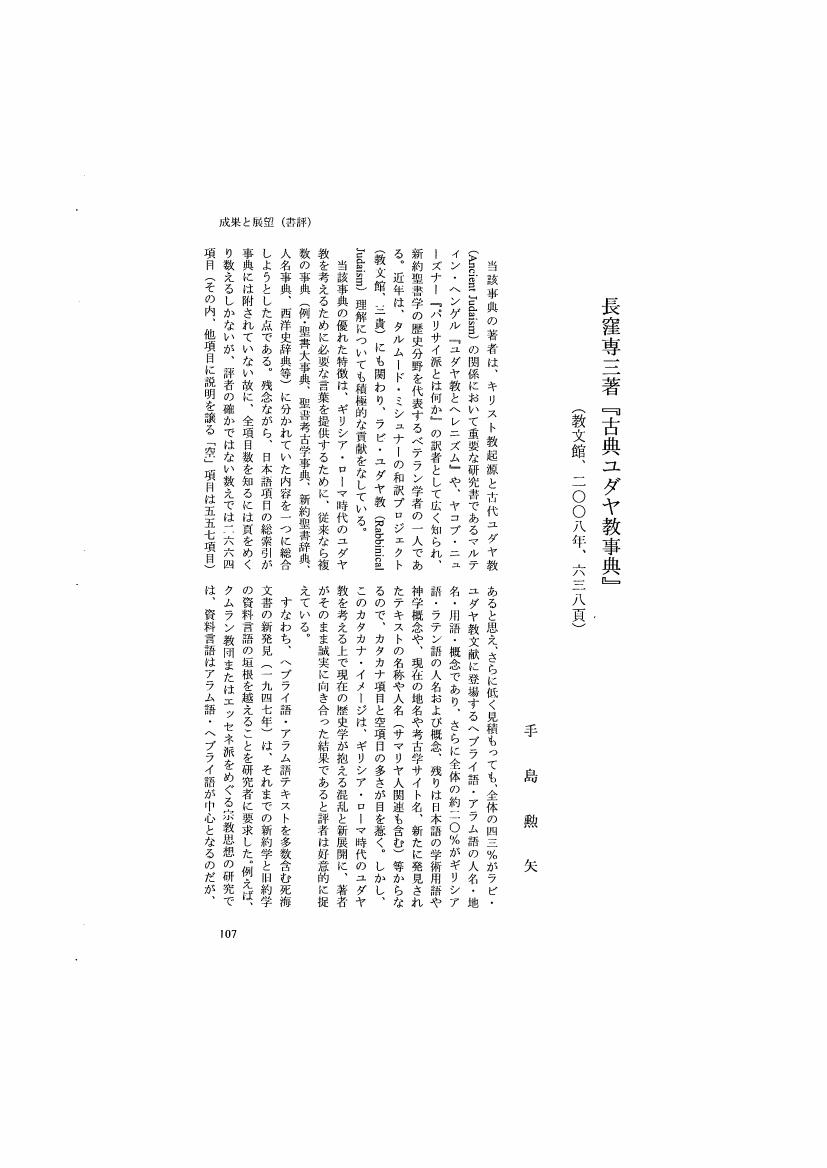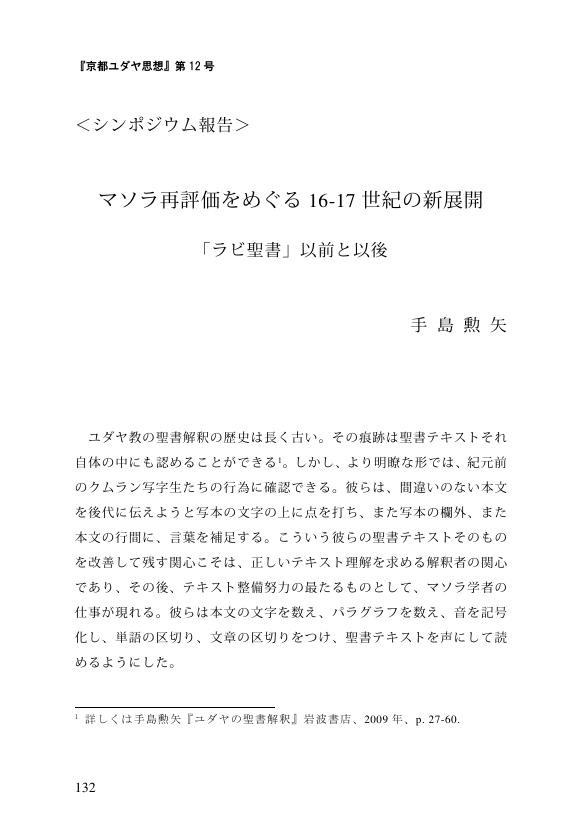- 著者
- 手島 勲矢
- 出版者
- 岩波書店
- 雑誌
- 文学 (ISSN:03894029)
- 巻号頁・発行日
- vol.2, no.6, pp.44-51, 2001-11
4 0 0 0 OA 長窪専三著『古典ユダヤ教事典』(教文館、二〇〇八年、六三八頁)
- 著者
- 手島 勲矢
- 出版者
- The Japan Society of Christian Studies
- 雑誌
- 日本の神学 (ISSN:02854848)
- 巻号頁・発行日
- vol.48, pp.107-112, 2009-08-28 (Released:2011-11-09)
- 著者
- 手島 勲矢
- 出版者
- 日本宗教学会
- 雑誌
- 宗教研究 (ISSN:03873293)
- 巻号頁・発行日
- vol.83, no.4, pp.1372-1373, 2010-03-30
2 0 0 0 OA マソラ再評価をめぐる16-17世紀の新展開 「ラビ聖書」以前と以後
- 著者
- 手島 勲矢
- 出版者
- 京都ユダヤ思想学会
- 雑誌
- 京都ユダヤ思想 (ISSN:21862273)
- 巻号頁・発行日
- vol.12, pp.132-160, 2021-12-20 (Released:2023-04-07)
2 0 0 0 OA 初期の聖書註解と本文批評
- 著者
- 手島 勲矢
- 出版者
- 一般社団法人 日本オリエント学会
- 雑誌
- オリエント (ISSN:00305219)
- 巻号頁・発行日
- vol.38, no.1, pp.33-44, 1995-09-30 (Released:2010-03-12)
Textual criticism of the Hebrew Bible is often described as requiring both “scientific” and “artistic” qualities in balance. However rigorously one conducts the weighing of essential data of manuscripts and witnesses and accounts for variants by textual principles, it is impossible to prove scientifically every textual decision one makes; it is particularly frustrating when one faces equally probable variants of MT, LXX, and the Qumran evidence, where any preference for one reading or another is arbitrary. This paper will argue that, in such a case, knowledge of early biblical interpretation can equip textual critcs with additional means to grade such ancient variants.For the proposed study I will use exegetical material from rabbinic and Second Temple texts to help determine what is a pristine reading and what are scribal variants. In particular, choosing a problematic biblical account of David and Bathsheba's incident, I will focus on textual variants of LXX (Lucianic and non-Lucianic readings), Targum, MT, and 4QSam concerning three specific parts of 2Sam 11: 2, 4: 1)_??__??__??__??__??_2)_??__??__??_3)_??__??__??_. Examining how these parts determine the understanding of the story as a whole in midrashim, a Talmudic discourse, Josephus' Jewish Antiquities, and the Damascus Document, and suggesting specific concerns of early biblical exegetes about these parts, I will try to show how the concerned variants address themselves to these exegetical concerns. In this way, the study proposes to determine the degree of tendentiousness in each variant, which will be a guideline to sort out a superior reading.Thus, the paper will not only stimulate fundamental thoughts as to the present practices of textual criticism but also expose the richness of early biblical interpretation of the biblical account in the exegetical problems as well as the solutions.
1 0 0 0 OA 論争としてのハシディズム
- 著者
- 手島 勲矢
- 出版者
- 京都ユダヤ思想学会
- 雑誌
- 京都ユダヤ思想 (ISSN:21862273)
- 巻号頁・発行日
- vol.5, pp.96-103, 2015-06-15 (Released:2022-11-16)
1 0 0 0 OA ユダヤの宗教哲学について 〈個〉有名詞と普通名詞の関係から
- 著者
- 手島 勲矢
- 出版者
- 宗教哲学会
- 雑誌
- 宗教哲学研究 (ISSN:02897105)
- 巻号頁・発行日
- vol.28, pp.75-80, 2011 (Released:2019-09-18)
1 0 0 0 OA ユダヤ思想と二種類の名前 イブン・エズラの『名詞論』から
- 著者
- 手島 勲矢
- 出版者
- 宗教哲学会
- 雑誌
- 宗教哲学研究 (ISSN:02897105)
- 巻号頁・発行日
- vol.28, pp.1-15, 2011 (Released:2019-09-18)
Since the time of Aristobulus and Philo of Alexandria, through the age of Moses Maimonides and Judah Halevy, Jewish thought has always developed within both sympathies and antipathies with Greek philosophy. This paper will argue that the ambivalent postures of Jewish thought to Greek philosophy has not only cultural motives but also a logical base in Jewish understanding of human language, which tends to appreciate the “private name” which is for calling one another in the speech of I-Thou, more than the “proper name” for identifying an object as “It” in the general analysis of philosophy. The claim is inspired by the theory of Abraham Ibn Ezra, a Hebrew grammarian in the 12th Century, who distinguishes two kinds of name, i.e., shem ha-etzem (the name of substance) which is the private name used to recognize the only one as unique irreplaceable being, and shem ha-toar (the name of appearance) which is to signify the groups, the types, or the kinds of things by observation of similarities and dissimilarities. Ibn Ezra understands that the reality can not be truly grasped except addressing it as unique with shem ha-etzem, whereas he explains shem ha-toar as a name expressing the imaginative side of reality as perceived by human sense and reason, therefore, connoting the semantic hollowness of generalization by human language. Because of this distinction of the two names, the paper will maintain that Jewish thought reaches the explanations of the world, human, and God as different from those of Greek philosophy, since the latter emphasizes more on the importance of the general name for identifying kinds and types which human language creates about phenomena, while Jewish thought tends to respect more the other name which functions to recognize not only God but everyone of human being as unique and only one in the universe.
1 0 0 0 スピノザの名前/事物の思想 : ヘブライ語から見た『エチカ』の言語 (特集号 創立10周年記念・東京大会) -- (記念シンポジウム「いま倫理(エティカ)とはなにか スピノザを考える」)
- 著者
- 手島 勲矢
- 出版者
- 京都ユダヤ思想学会
- 雑誌
- 京都ユダヤ思想 = Journal of Kyoto Association of Jewish Thought (ISSN:21862273)
- 巻号頁・発行日
- no.11, pp.27-52, 2020-07
- 著者
- 手島 勲矢
- 出版者
- 国際基督教大学キリスト教と文化研究所
- 雑誌
- 人文科学研究 (ISSN:00733938)
- 巻号頁・発行日
- no.29, pp.99-124, 1998-03
1 0 0 0 IR <論文>聖書翻訳とヘブライ語原典--東方正教会を考える視点
- 著者
- 手島 勲矢
- 出版者
- 京都大学キリスト教学研究室
- 雑誌
- キリスト教学研究室紀要 = The Annual Report on Christian Studies
- 巻号頁・発行日
- vol.4, pp.57-73, 2016-03
1 0 0 0 OA <論文>聖書翻訳とヘブライ語原典--東方正教会を考える視点
- 著者
- 手島 勲矢
- 出版者
- 京都大学キリスト教学研究室
- 雑誌
- キリスト教学研究室紀要 = The Annual Report on Christian Studies
- 巻号頁・発行日
- vol.4, pp.57-73, 2016-03




